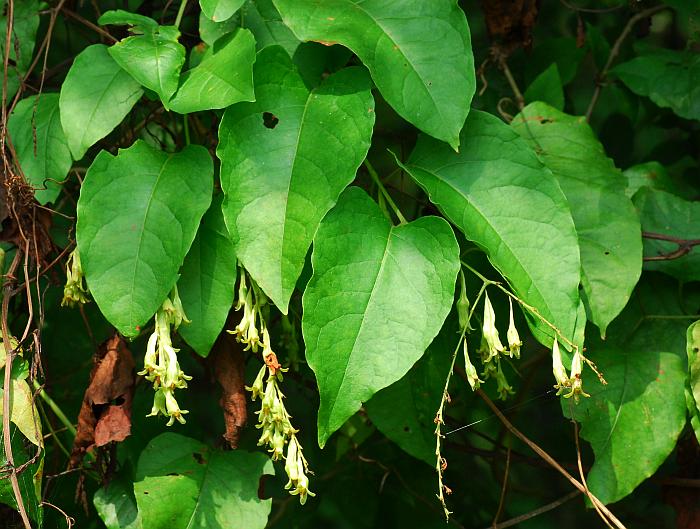Brunnichia ovata (Walter) Shinners
Ladies' Eardrops

Native
CC = 4
CW = -3
MOC = 9
© SRTurner
Brunnichia ovata (Walter) ShinnersLadies' Eardrops | |
 |
Native CC = 4 CW = -3 MOC = 9 |
© SRTurner |
|
Family - Polygonaceae Habit - Fibrous-rooted liana. Stem - Vining, climbing, to 15 m long, woody near the base, frequently spreading across soil or water and rooting at the nodes, but also climbing on other vegetation or other support, branched, glabrous or finely hairy toward the tip. Ocreae reduced to a short ring to 1 mm long, this usually with dense reddish brown hairs along the margin.
Leaves - Alternate, the petiole 7-25 mm long, somewhat expanded basally and partially sheathing the stem. Leaf blades 2-15 cm long, 1-8 cm wide, ovate or occasionally heart-shaped, those near the stem tips sometimes lanceolate, usually appearing somewhat folded longitudinally, tapered to a sharply pointed tip, truncate to shallowly cordate at the base, the narrowest leaves sometimes angled at the base, the margins entire, glabrous or the undersurface sparsely and inconspicuously short-hairy.
Inflorescence - Axillary spikelike racemes and terminal panicles with spicate branches, the flowers usually 3-5 in small fascicles subtended by ocreolae, often pendant at maturity, often appearing positioned on 1 side of the axis, subtended by inconspicuous, scalelike bracts 1-3 mm long.
Flowers - Flowers perfect, relatively long-stalked, the stalk jointed in the lower third, 3-winged above the joint, 1 of the wings becoming enlarged at fruiting creating the appearance of an elongate, flattened, basal wing. Tepals 5 in 2 whorls, 3-4 mm long at flowering, fused toward the base, with a slender stalklike basal extension, greenish white and spreading as the flower opens, but quickly turning green to yellowish green, glabrous, at fruiting becoming slightly enlarged, incurved, and leathery or hardened. Stamens 8, exserted at flowering, but later appearing included in the enlarged, incurved perianth, the anthers attached toward their midpoints. Styles 3, the stigmas capitate to somewhat disc-shaped.
Fruits - Achenes enclosed in the persistent perianth, 8-10 mm long, 3-angled, unwinged, narrowly ovate in outline, short-beaked, brown, glabrous.
Flowering - May - August. Habitat - Swamps, bottomland forests, sloughs, ditches, crop fields, roadsides, moist disturbed areas. Origin - Native to the U.S. Lookalikes - When not flowering, the vines can somewhat resemble numerous other climbing species, such as Smilax sp, Vitis sp, or Ampelopsis cordata. Other info. - This vine is a common sight in wet areas of Missouri's Bootheel, but is absent from the remainder of the state. Its U.S. distribution comprises a tight cluster extending from eastern Texas to western Florida, and northward into the lower parts of Missouri and Illinois. The plant can sometimes can be a troublesome weed in crop fields, particularly in soybeans. It is relatively resistant to glyphosate herbicides and thus grows well in fields of glyphosate-resistant soybeans. The plants can be controlled by deep tilling, which disrupts the relatively fine root systems. Photographs taken at Otter Slough Conservation Area, Stoddard County, MO, 9-8-2019 and 8-15-2021, and at Mingo NWR, Stoddard County, MO, 9-10-2019 (SRTurner). |